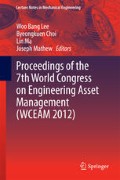Abstract
Cavitation is one of the major problems associated with the operation of centrifugal pumps. Cavitation occurs when vapor bubbles that are formed due to a drop in pressure in the pipes upstream of the centrifugal pump implode under the added pressure within the volute of the pump. These implosions wear away the impeller, and sometimes the volute itself, which if left unchecked, would render the pump inoperable. Much research has been done in the detection of cavitation through: indicators in certain audible frequencies, drop in the net positive suction head (NPSHa), visual inspection using a transparent casing and a stroboscopic light, paint erosion inside the volute, and on the impeller, changes in pressure within the flow or volute, and vibration within certain frequency ranges. Vibration detection is deemed as one of the more difficult methods due to other structural and environmental factors that may influence which frequencies may be present during the onset of cavitation. Vibration measurement, however, is most easily measured and deployable in an automated condition monitoring scenario. It is proposed that an increasing trend in a set of statistical parameters, rather than a firm threshold of a single parameter, would provide a robust indication for the onset of cavitation. Trends in these statistical parameters were obtained from data collected on a pump forced to cavitate under several different operating conditions. A single cavitation indicator is outlined utilizing these statistical parameters that can quantify the level of cavitation in a centrifugal pump.
Access this chapter
Tax calculation will be finalised at checkout
Purchases are for personal use only
References
McKee K, Forbes G, Mazhar I, Entwistle R, Howard I (2011) A review of machinery diagnostics and prognostics implemented on a centrifugal pump. In: Jay Lee JN, Mathew J (eds) Proceedings of the 6th world congress on engineering asset management
Čudina M (2003) Detection of cavitation phenomenon in a centrifugal pump using audible sound. Mech Syst Signal Process 17:1335–1347
Černetič J, Čudina M (2011) Estimating uncertainty of measurements for cavitation detection in a centrifugal pump. Measurement 44:1293–1299
Čudina M, Prezelj J (2009) Detection of cavitation in operation of kinetic pumps. Use of discrete frequency tone in audible spectra. Appl Acoust 70:540–546
Neil GD, Reuben RL, Sandford PM, Brown ER, Steel JA (1997) Detection of incipient cavitation in pump using acoustic emission. Proc Inst Mech Eng 211:267–277
Alfayez L, Mba D, Dyson G (2005) The application of acoustic emission for detecting incipient cavitation and the best efficiency point of a 60 kW centrifugal pump: case study. NDT and E Int 38:354–358
Athavale MM, Li HY, Jiang Y, Singhal AK (2002) Application of the full cavitation model to pumps and inducers. Int J Rotating Mach 8:45–56
Hofmann MaS B, Coutier-Delgosha O, Fortes-Patella R, Reboud JL (2001) Experimental and numerical studies on a centrifugal pump with 2D-curved blades in cavitating condition. In: CAV 2001: Fourth international symposium on cavitation. California Institute of Technology, Pasadena, CA USA, 20–23 Jun 2001
Uchiyama T (1998) Numerical simulation of cavitating flow using the upstream finite element method. Appl Math Model 22:235–250
Franz R, Acosta AJ, Brennen CE, Caughey TK (1990) The rotordynamic forces on a centrifugal pump impeller in the presence of cavitation. Trans ASME: J Fluids Eng 112:264–271
Rapposelli E, Cervone A, d’Agostino L (2002) A new cavitating pump rotordynamic test facility. In: 38th AIAA/ASME/SAE/ASEE joint propulsion conference and exhibit, Indianapolis, Indiana
Jensen J, Dayton K (2000) Detecting cavitation in centrifugal pumps. Orbit, Nevada
McKee KK, Forbes G, Mazhar I, Entwistle R, Howard I (2012) Modification of the ISO-10816 centrifugal pump vibration severity charts for use with Octave band spectral measurements. In Kotousov A (ed) 7th Australasian congress on applied mechanics, Adelaide
Standardization IOf (1998) ISO 10816-3: Mechanical vibration—evaluation of machine vibration by measurements on non-rotating parts—in Part 3: industrial machines with nominal power above 15 kW and nominal speeds between 120 r/min and 15 000 r/min when measured in situ, ISO, Switzerland
Standardization IOf (2009) ISO 10816-7: Mechanical vibration—evaluation of machine vibration by measurements on non-rotating parts. In: Part 7: rotordynamic pumps for industrial applications, including measurements on rotating shafts, ISO, Switzerland
Standardization IOf (1975) ISO 532: method for calculating loudness level. International Organization for Standardization, Switzerland
Wold S, Esbensen K, Geladi P (1987) Principal component analysis. Chemometr Intell Lab Syst 2:37–52
Blagrove L (2003) Cavitation detection in centrifugal pumps using vibration signals and fractal analysis. School of Mechanical and Chemical Engineering, University of Western Australia
Acknowledgments
This research was conducted within the CRC for Infrastructure and Engineering Asset Management, established, and supported under the Australian Government’s Cooperative Research Centres Programme. The authors would also like to thank Professor Melinda Hodkiewicz for facilitating the vibration measurements.
Author information
Authors and Affiliations
Corresponding author
Editor information
Editors and Affiliations
Rights and permissions
Copyright information
© 2015 Springer International Publishing Switzerland
About this paper
Cite this paper
McKee, K.K., Forbes, G., Mazhar, I., Entwistle, R., Hodkiewicz, M., Howard, I. (2015). A Single Cavitation Indicator Based on Statistical Parameters for a Centrifugal Pump. In: Lee, W., Choi, B., Ma, L., Mathew, J. (eds) Proceedings of the 7th World Congress on Engineering Asset Management (WCEAM 2012). Lecture Notes in Mechanical Engineering. Springer, Cham. https://doi.org/10.1007/978-3-319-06966-1_42
Download citation
DOI: https://doi.org/10.1007/978-3-319-06966-1_42
Published:
Publisher Name: Springer, Cham
Print ISBN: 978-3-319-02461-5
Online ISBN: 978-3-319-06966-1
eBook Packages: EngineeringEngineering (R0)

